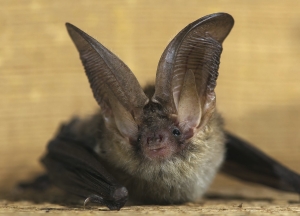Join the Bat Tour!

By Mary Rose Thomas-Glaser
Bats are the world’s only true flying mammal. They live in habitats ranging from wetlands to cities and represent over 25 percent of the world’s mammal population. Despite the popular belief that they’re dirty and dangerous, bats play a vital role in the ecosystem by controlling insects, pollinating plants and dispersing seeds. In one night, a single bat can consume up to 2,000 insects, finding their prey in the skies using echolocation.
Threats to Bat Populations
Throughout the world there are 950 identified species of bats, but according to some chiropterologists there may be over 1,200. They range in size from the teeny one-inch long bumblebee bat in Thailand to the rare giant golden-crowned flying fox megabat in the Philippines, which has a wingspan of up to 5.5 feet!
Bats are threatened by habitat loss, wind turbines and white-nose syndrome, a fungal disease that has killed millions of bats in the U.S. in recent years. The impact of these losses is exacerbated by one of the slowest animal reproductive rates: females give birth to only one pup a year. In the next 50 years, experts believe that one in every five bat species will be threatened with extinction.
Calling All Bat Detectives
To help track changes in bat populations around the globe, the Indicator Bats Program (iBats) is using volunteers to collect acoustic data on bats in their area using a free smartphone app. Once connected to an ultrasonic bat detector, recorded data can be uploaded directly into the iBats website to monitor population trends.
The Bat Detective World Tour uses citizen scientists to listen to bat call recordings to help identify different types of calls and sequences from various species. The goal of this classification process is to create an automated program where researchers can access call information to help track bat populations.
The Bat Detective World Tour launched in Europe, traveled to sub-Saharan Africa and arrived in New York City on February 1, 2016.
Classroom Discussion
- Why are wind turbines so lethal to bats and what can be done to protect bats from the dangers?
- How does echolocation help bats find insect prey? What other animals use echolocation?
Visit www.batdetective.org (Classify tab) and listen to the social, searching and feeding “spectrograms.” How do the sounds differ?
Vocabulary:
- Chiropterology
- Echolocation
- Spectrogram
- Habitat
